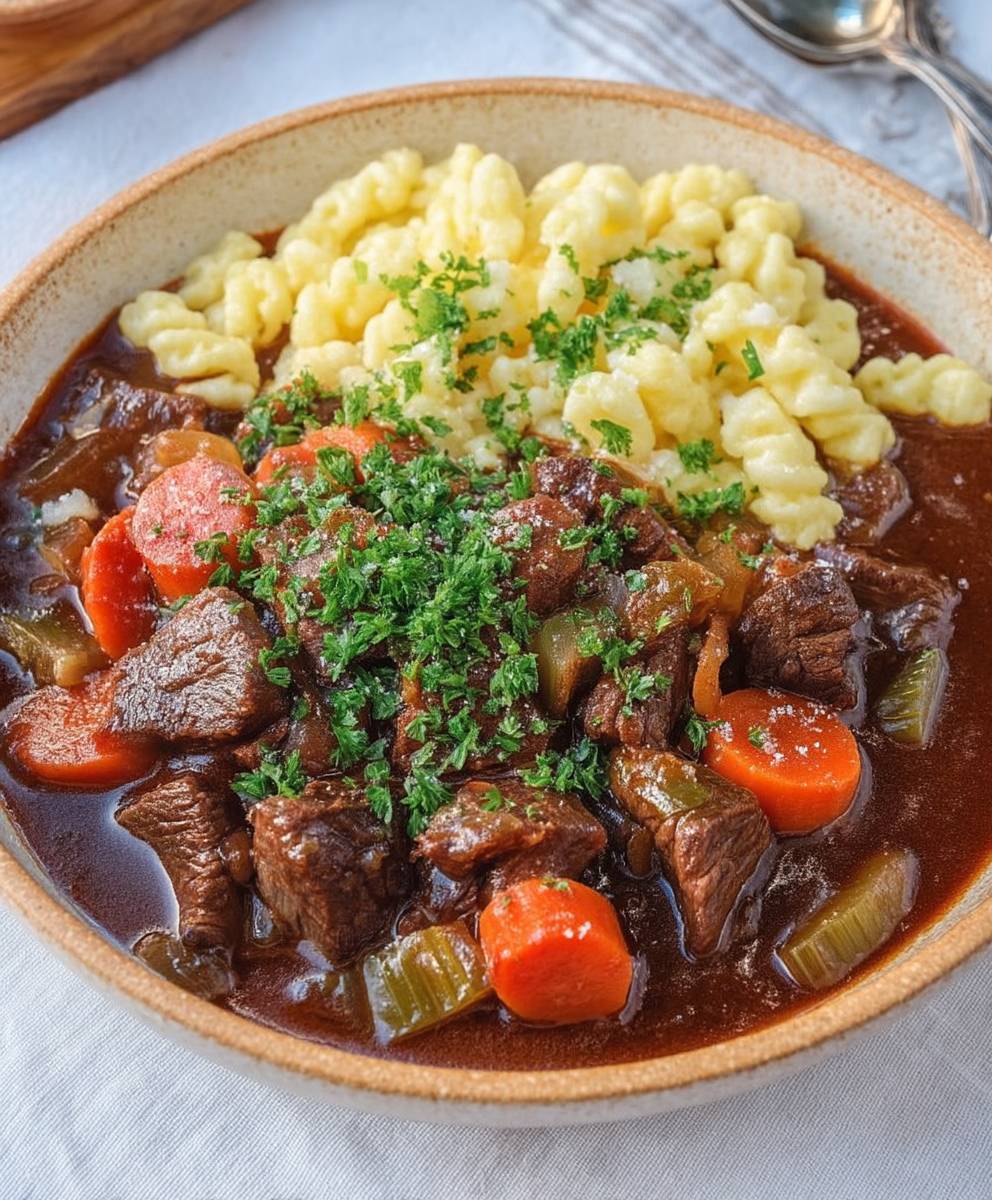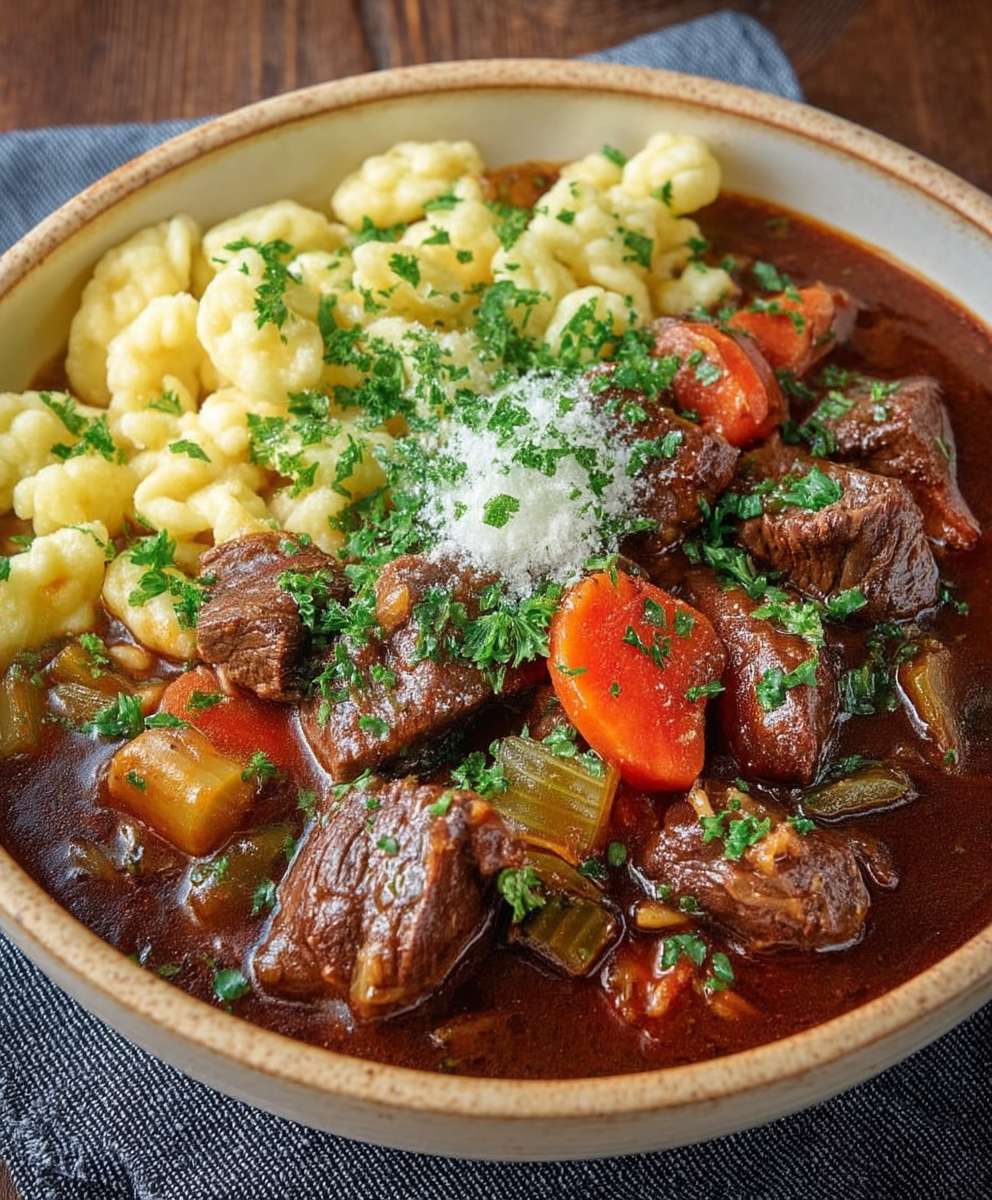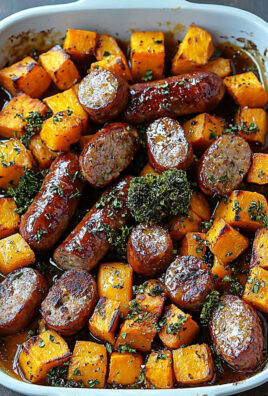German Goulash, or Deutsches Gulasch, isn’t just a hearty stew; it’s a warm hug in a bowl, a taste of history, and a testament to the resourcefulness of German cuisine. Have you ever craved a dish that’s both deeply comforting and surprisingly flavorful? A dish that fills your kitchen with an aroma that makes everyone gather around the table with anticipation? Then you’ve come to the right place!
Goulash, in its various forms, has a rich history stretching back to medieval Hungary, where herdsmen cooked meat in cauldrons over open fires. Over time, the dish migrated and evolved, with each region adding its own unique twist. German Goulash distinguishes itself with its use of regional spices and often includes additions like potatoes and dumplings, creating a complete and satisfying meal. It’s a dish that speaks of tradition, passed down through generations, each family adding their own secret ingredient or technique.
What makes this particular version so beloved? It’s the perfect balance of tender, slow-cooked beef, the subtle sweetness of caramelized onions, and the rich, savory broth infused with paprika, caraway, and other aromatic spices. The meat practically melts in your mouth, and the gravy is perfect for soaking up with crusty bread or spooning over fluffy dumplings. It’s a dish that’s both incredibly satisfying and relatively easy to prepare, making it a weeknight winner and a crowd-pleasing centerpiece for special occasions. So, let’s get cooking and create a pot of deliciousness that will warm your heart and soul!
Ingredients:
- 2 lbs beef chuck, cut into 1-inch cubes
- 2 large onions, chopped
- 2 red bell peppers, seeded and chopped
- 2 yellow bell peppers, seeded and chopped
- 4 cloves garlic, minced
- 2 tablespoons sweet paprika
- 1 tablespoon smoked paprika
- 1 teaspoon caraway seeds
- 1/2 teaspoon marjoram
- 1/4 teaspoon cayenne pepper (optional)
- 2 tablespoons tomato paste
- 4 cups beef broth
- 1 cup dry red wine (optional)
- 2 tablespoons all-purpose flour
- 2 tablespoons olive oil
- 1 tablespoon red wine vinegar
- Salt and freshly ground black pepper to taste
- 1 bay leaf
- Fresh parsley, chopped (for garnish)
- Sour cream (for serving, optional)
Browning the Beef:
This is a crucial step for developing deep, rich flavor in your goulash. Don’t skip it, and don’t overcrowd the pan!
- Pat the beef cubes dry with paper towels. This helps them brown properly instead of steaming. Season generously with salt and freshly ground black pepper.
- Heat the olive oil in a large, heavy-bottomed pot or Dutch oven over medium-high heat. You want the oil to be shimmering hot, but not smoking.
- Working in batches, brown the beef on all sides. Don’t overcrowd the pot, or the beef will steam instead of brown. If necessary, brown the beef in three or four batches. Remove the browned beef from the pot and set aside.
Building the Flavor Base:
Now we’re going to create the aromatic foundation for our goulash. Take your time and let the vegetables soften and release their flavors.
- Add the chopped onions to the pot and cook over medium heat until softened and translucent, about 5-7 minutes. Stir occasionally to prevent burning.
- Add the chopped bell peppers and minced garlic to the pot. Cook for another 5-7 minutes, stirring occasionally, until the peppers are slightly softened and the garlic is fragrant. Be careful not to burn the garlic.
- Stir in the sweet paprika, smoked paprika, caraway seeds, marjoram, and cayenne pepper (if using). Cook for 1 minute, stirring constantly, until fragrant. This step is important to bloom the spices and release their flavors.
- Stir in the tomato paste and cook for another minute, stirring constantly. This will help to caramelize the tomato paste and add depth of flavor.
Bringing it All Together:
This is where the magic happens! We’ll combine the browned beef, flavorful vegetables, and liquids to create a rich and hearty stew.
- Pour in the beef broth and red wine (if using), scraping up any browned bits from the bottom of the pot. These browned bits are packed with flavor!
- Return the browned beef to the pot. Add the bay leaf.
- Bring the mixture to a simmer, then reduce the heat to low, cover the pot, and simmer for at least 2-3 hours, or until the beef is very tender. The longer it simmers, the more flavorful it will become. Check occasionally and add more beef broth if needed to keep the beef submerged.
Thickening and Finishing:
We’ll thicken the goulash to the perfect consistency and add a final touch of brightness.
- In a small bowl, whisk together the all-purpose flour and 1/4 cup of cold water to form a smooth slurry. This is called a “beurre manié” and will help to thicken the goulash without creating lumps.
- Gradually whisk the flour slurry into the simmering goulash. Stir constantly until the goulash has thickened slightly, about 2-3 minutes.
- Remove the bay leaf.
- Stir in the red wine vinegar. This will add a touch of acidity to balance the richness of the goulash.
- Taste and adjust the seasoning with salt and freshly ground black pepper as needed.
Serving Suggestions:
Goulash is delicious served in a variety of ways. Here are a few of my favorites:
- Serve hot, garnished with fresh parsley and a dollop of sour cream (if desired).
- Goulash is traditionally served with spätzle (German egg noodles), but it’s also delicious with mashed potatoes, egg noodles, or crusty bread.
- For a complete meal, serve with a side of green beans or a simple salad.
Tips and Variations:
Here are a few tips and variations to help you customize this recipe to your liking:
- Beef Selection: While beef chuck is the traditional choice, you can also use other cuts of beef, such as beef shoulder or round roast. Just be sure to choose a cut that is well-marbled and will become tender during long simmering.
- Spice Level: Adjust the amount of cayenne pepper to your liking. If you prefer a milder goulash, omit the cayenne pepper altogether.
- Vegetable Variations: Feel free to add other vegetables to the goulash, such as carrots, parsnips, or potatoes. Add them along with the bell peppers.
- Beer Option: Instead of red wine, you can use a dark beer, such as a stout or porter. This will add a slightly different flavor profile to the goulash.
- Slow Cooker Option: This recipe can easily be adapted for the slow cooker. Brown the beef and sauté the vegetables as directed in the recipe. Then, transfer everything to a slow cooker and cook on low for 6-8 hours, or on high for 3-4 hours. Thicken the goulash with the flour slurry during the last 30 minutes of cooking.
- Make Ahead: Goulash is even better the next day! The flavors meld together and deepen as it sits. You can make it a day or two in advance and store it in the refrigerator. Reheat gently before serving.
- Freezing: Goulash freezes well. Let it cool completely before transferring it to freezer-safe containers. It can be stored in the freezer for up to 3 months. Thaw overnight in the refrigerator before reheating.
Troubleshooting:
Sometimes things don’t go exactly as planned. Here are a few common problems and how to fix them:
- Goulash is too thin: If the goulash is not thick enough, you can add more flour slurry. Whisk together 1 tablespoon of flour with 2 tablespoons of cold water and stir it into the simmering goulash. Cook for a few minutes until thickened. Alternatively, you can simmer the goulash uncovered for a longer period of time to allow some of the liquid to evaporate.
- Goulash is too thick: If the goulash is too thick, add a little more beef broth or water until it reaches the desired consistency.
- Beef is not tender: If the beef is not tender after 2-3 hours of simmering, continue to simmer it for longer. Some cuts of beef may require more time to become tender.
- Goulash is too salty: If the goulash is too salty, add a pinch of sugar or a splash of vinegar to balance the flavors. You can also add a peeled potato to the goulash and simmer it for 30 minutes. The potato will absorb some of the salt. Remove the potato before serving.
- Goulash is too bland: If the goulash is not flavorful enough, add more spices, such as paprika, caraway seeds, or marjoram. You can also add a tablespoon of Worcestershire sauce or soy sauce for extra umami flavor.
Nutritional Information (Approximate):
Please note that the nutritional information is an estimate and may vary depending on the specific ingredients used.
- Calories: Approximately 450-550 per serving
- Protein: 30-40 grams per serving
- Fat: 25-35 grams per serving
- Carbohydrates: 15-25 grams per serving
Enjoy your delicious homemade German Goulash!
Conclusion:
So, there you have it! This German Goulash recipe isn’t just another stew; it’s a warm hug in a bowl, a taste of tradition, and a guaranteed crowd-pleaser. I truly believe this is a must-try recipe for anyone looking to expand their culinary horizons and experience authentic German flavors. The rich, savory broth, the tender chunks of beef, and the subtle hint of paprika create a symphony of tastes that will leave you wanting more. It’s hearty, comforting, and surprisingly easy to make, even for beginner cooks.
But why is this particular German Goulash so special? It’s all about the depth of flavor. The slow simmering process allows the spices to meld together perfectly, creating a complex and satisfying dish that’s far more than the sum of its parts. Plus, it’s incredibly versatile! While I’ve shared my family’s classic recipe, feel free to experiment and make it your own.
Serving Suggestions and Variations:
Traditionally, German Goulash is served with hearty sides that complement its richness. My personal favorite is creamy mashed potatoes – the perfect canvas to soak up all that delicious gravy. Spaetzle, those delightful little German noodles, are another fantastic option. They add a lovely chewy texture that contrasts beautifully with the tender beef. For a lighter touch, try serving it with crusty bread for dipping or alongside a simple green salad to balance the richness.
Want to put your own spin on things? Here are a few variations to consider:
- Spice it up: Add a pinch of cayenne pepper or a dash of hot sauce for a little extra kick.
- Vegetable boost: Incorporate other root vegetables like parsnips or turnips for added sweetness and earthiness.
- Wine lover’s twist: Substitute some of the beef broth with a dry red wine for a deeper, more complex flavor profile. Just be sure to simmer it for a bit longer to allow the alcohol to cook off.
- Creamy indulgence: Stir in a dollop of sour cream or crème fraîche just before serving for a richer, creamier texture.
- Slow Cooker Option: This recipe translates beautifully to the slow cooker. Simply brown the beef and onions as instructed, then transfer everything to your slow cooker and cook on low for 6-8 hours.
No matter how you choose to serve it, I’m confident that this German Goulash will become a new favorite in your household. It’s perfect for a cozy weeknight dinner, a festive gathering, or even a make-ahead meal for busy days. The leftovers (if there are any!) are even more delicious the next day, as the flavors have had even more time to meld together.
I truly hope you’ll give this recipe a try. It’s more than just a meal; it’s an experience, a journey to the heart of German cuisine. And I’m so excited for you to embark on that journey! Once you’ve made it, I’d absolutely love to hear about your experience. Did you make any variations? What sides did you serve it with? What did your family think? Please, share your thoughts and photos in the comments below. Your feedback is invaluable, and it helps me continue to create and share recipes that you’ll love. Happy cooking, and Guten Appetit!
German Goulash: The Authentic Recipe You Need to Try
Hearty and flavorful German Goulash with tender beef, sweet peppers, and aromatic spices. A comforting stew perfect for a cold day.
Ingredients
Instructions
Recipe Notes
- Beef Selection: While beef chuck is the traditional choice, you can also use other cuts of beef, such as beef shoulder or round roast.
- Spice Level: Adjust the amount of cayenne pepper to your liking.
- Vegetable Variations: Feel free to add other vegetables to the goulash, such as carrots, parsnips, or potatoes. Add them along with the bell peppers.
- Beer Option: Instead of red wine, you can use a dark beer, such as a stout or porter.
- Slow Cooker Option: This recipe can easily be adapted for the slow cooker. Brown the beef and sauté the vegetables as directed in the recipe. Then, transfer everything to a slow cooker and cook on low for 6-8 hours, or on high for 3-4 hours. Thicken the goulash with the flour slurry during the last 30 minutes of cooking.
- Make Ahead: Goulash is even better the next day!
- Freezing: Goulash freezes well. Let it cool completely before transferring it to freezer-safe containers. It can be stored in the freezer for up to 3 months. Thaw overnight in the refrigerator before reheating.
- Goulash is too thin: If the goulash is not thick enough, you can add more flour slurry. Whisk together 1 tablespoon of flour with 2 tablespoons of cold water and stir it into the simmering goulash. Cook for a few minutes until thickened. Alternatively, you can simmer the goulash uncovered for a longer period of time to allow some of the liquid to evaporate.
- Goulash is too thick: If the goulash is too thick, add a little more beef broth or water until it reaches the desired consistency.
- Beef is not tender: If the beef is not tender after 2-3 hours of simmering, continue to simmer it for longer. Some cuts of beef may require more time to become tender.
- Goulash is too salty: If the goulash is too salty, add a pinch of sugar or a splash of vinegar to balance the flavors. You can also add a peeled potato to the goulash and simmer it for 30 minutes. The potato will absorb some of the salt. Remove the potato before serving.
- Goulash is too bland: If the goulash is not flavorful enough, add more spices, such as paprika, caraway seeds, or marjoram. You can also add a tablespoon of Worcestershire sauce or soy sauce for extra umami flavor.





Leave a Comment